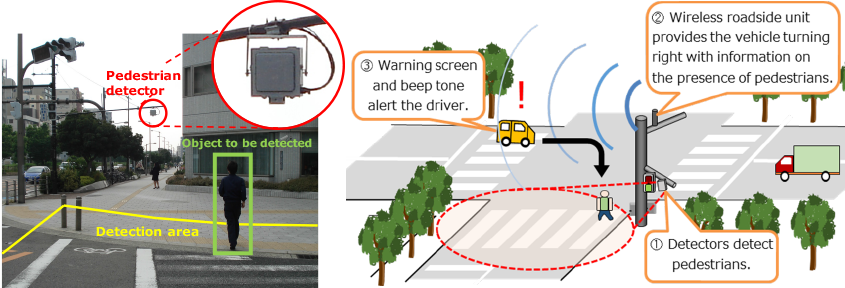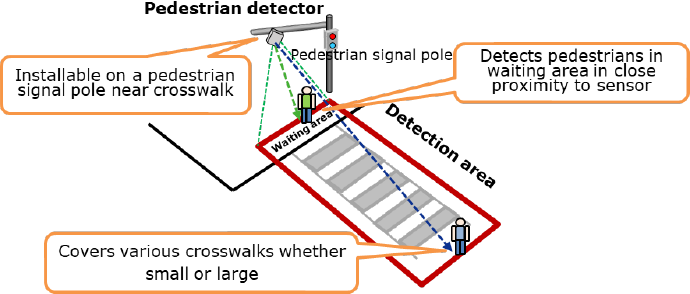ITS Infrastructure

- Products and Services
- ITS Infrastructure
- Detectors
Various detectors
Detectors using various media gather information essential to the traffic infrastructure and utilize such information to control traffic signals and provide necessary information.
Ultrasonic vehicle detector
An ultrasonic vehicle detector installed over a lane detects vehicles using the reflection of ultrasound transmitted by an ultrasonic transmitter/receiver.

■Structure, etc.
The detector consists of a ultrasonic transmitter/receiver and a controller.
A detector provided with two or more heads can detect vehicles in two or more lanes.
Two types are available for different detectable areas: the standard area (1.2 m wide) type and the narrow area (0.75 m wide) type.

Infrared beacon
Optical transmitter/receivers are installed right over lanes for two-way communications with vehicles (on-board units) using near infrared rays as media. Information on the time of passage and position is gathered from vehicles as uplink information, and traffic information such as traffic congestion information is provided to the vehicles as downlink information. The infrared beacon can also detect vehicles using the reflection of near infrared rays.

■Structure, etc.
The infrared beacon consists of optical transmitter/receivers and a controller.
An infrared beacon provided with two or more optical transmitter/receivers can communicate with vehicles in two or more lanes.
In addition to the advanced mobile information systems (AMIS) and traffic signal prediction systems (TSPS), infrared beacons can be used for the following systems.
・Public transportation priority systems (PTPS)
・Mobile operation control systems (MOCS)
・Fast emergency vehicle preemption systems (FAST)
■Features
The infrared beacon gathers probe information from on-board units compatible with the traffic signal prediction systems (TSPS) as uplink information. It also provides on-board units with information based on the traffic light color changing schedule as downlink information. On-board units (car navigation equipment) can use this information to provide the driver with information such as the recommended speed to pass the intersection ahead with a green light.
Image processing vehicle detector
An image processing vehicle detector can measure the traffic volume and speed and also detect abnormal events, such as traffic congestion and accidents, by processing images taken by a monitoring camera installed over roads. The traffic control center realizes optimal signal control by making use of such data.

■Structure, etc.
The detector consists of a camera and a controller.
Vehicles traveling in multiple lanes can be detected.
■Features
The camera can detect vehicles, measures the speed, identifies the type of vehicle, and measures the traffic congestion length.
Even for roads with many lanes, the detector can be installed using a short arm.
Optional functions include compressed transmission of still pictures, detection of parked vehicles, and measurement of abnormal traffic.
Image processing technology
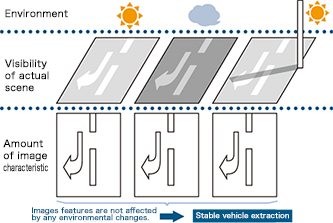
Vehicle detection using image processing
Our original algorithm combining the vehicle detection method based on brightness with the vehicle detection method based on peripheral increment sign, which is unlikely affected by image variation, can highly accurately detect and track vehicles even in cases where there are shadows of buildings or vehicles running side by side or the rapid change of solar irradiation occurs. For long distance measurement for DSSS or for measurement where there are both bright and dark spots, a full HD camera or wide dynamic range camera can be combined with this technology.
■Features
The license number plate can be read from a vehicle image, which can be utilized for, for example, travel time measurement.
License number plates in various conditions, such as bent or dirty plates, can be recognized.
Our original character recognition algorithm can handle license number plates in various countries.
Far infrared vehicle detector
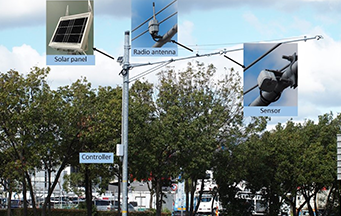
This detector uses far infrared rays to detect vehicles based on the temperature differences between the road surface and motor vehicles.
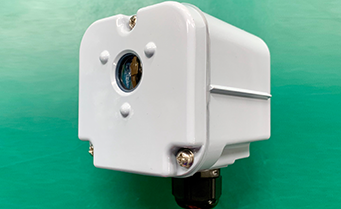
■Structure, etc.
The detector consists of a sensor and a controller.
The detector can detect vehicles in two or more lanes if provided with two or more sensors.
■Features
The sensor can also be powered by a solar panel. In this case, no power service wire is required.
The signal detected at the sensor can also be sent to the controller using wireless transmission. In this case, no wire installation is required.
Pedestrian detector (24 GHz-band millimeter-wave radar)
The pedestrian detector uses a 24 GHz-band millimeter wave radar.
The distance to objects can be measured by transmitting a radio wave and receiving the reflected wave from the objects and pedestrians on a crosswalk and in its surrounding area can be detected. The pedestrian detection information is provided from the wireless roadside unit to the vehicles entering the intersection and turning right and utilized for the driving safety support system to call drivers’ attention.
■Structure, etc.
The detector consists of a sensor section and a main unit.
■Features
Excellent performance in various environments: A millimeter-wave radar also maintains a high performance in various environmental conditions, such as various solar irradiation conditions: whether in daytime or at nighttime; and weather conditions: sunny or rainy.
High pedestrian detection accuracy: Our original pedestrian detection algorithm makes it possible to detect pedestrians behind passing vehicles who the driver may fail to see.
Wide detection area: Pedestrians both in the waiting area in close proximity to the detector and on the crosswalk of various sizes can be detected. With a high degree of flexibility for installation, the detector can be installed on, for example, the pedestrian signal light pole near the crosswalk.







